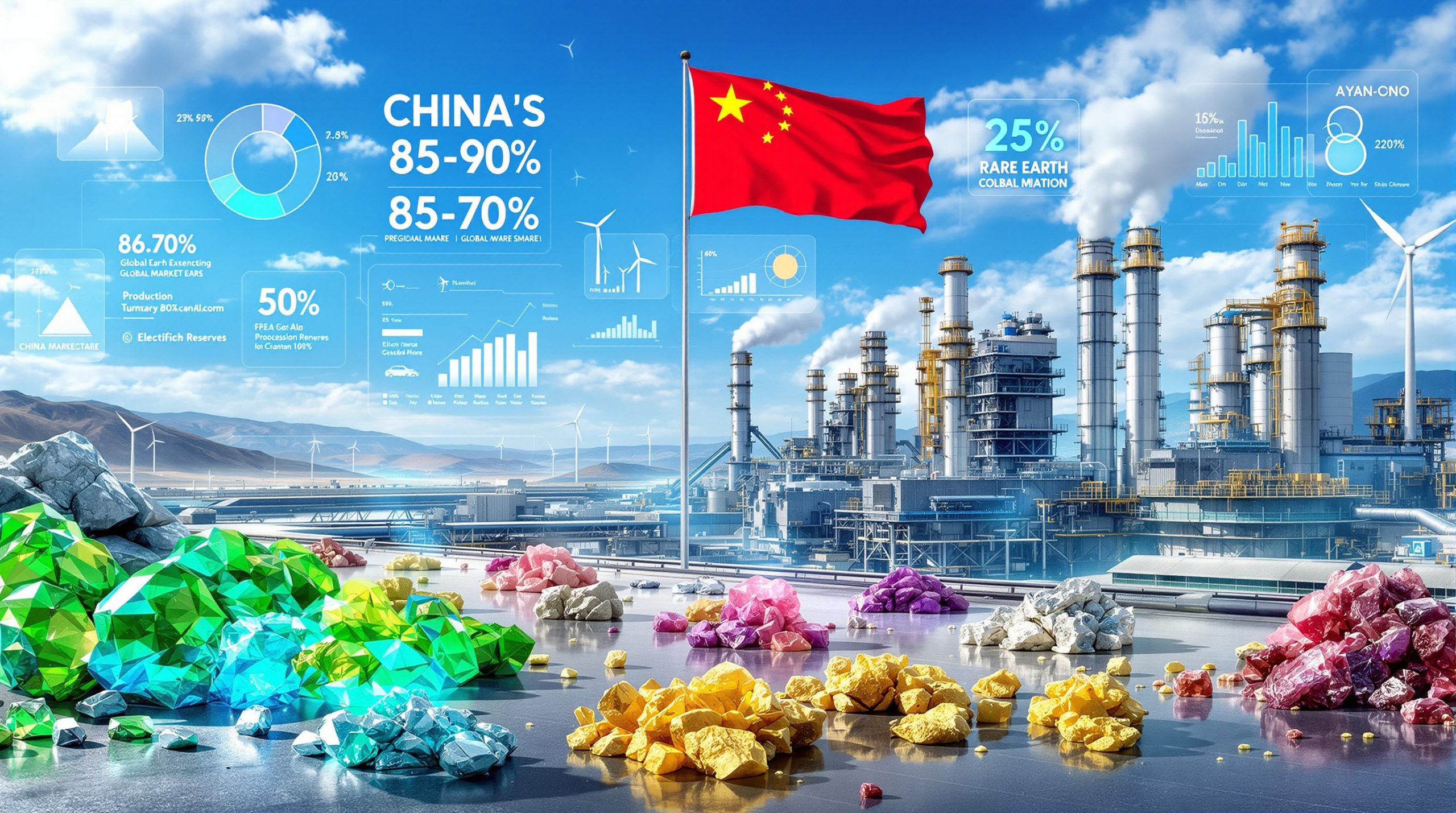China's 15th Five-Year Plan represents a fundamental transformation in economic strategy, moving decisively away from construction-heavy growth toward technology-driven sustainability. This strategic framework, covering 2026-2030, prioritises advanced manufacturing, renewable energy development, and environmental responsibility over traditional volume-based expansion.
The policy blueprint establishes clear targets for carbon peaking by 2030 and carbon neutrality by 2060, creating unprecedented demand patterns for base metals demand under China's 15th Five-Year Plan. Unlike previous economic models focused on real estate and infrastructure expansion, this plan emphasises resource efficiency and technological innovation across multiple industrial sectors.
Key strategic shifts include stricter environmental regulations, enhanced domestic mineral exploration, and increased investment in semiconductor manufacturing. These changes create distinct opportunities for different base metals, with some experiencing accelerated growth while others face supply constraints through capacity limitations. Furthermore, the mining industry evolution reflects these broader technological and environmental transitions.
Distinctive Features Separating This Plan from Previous Economic Strategies
The 15th Five-Year Plan marks a departure from infrastructure expansion toward resource optimisation and technological independence. Government policies now implement strict capacity controls across traditional heavy industries while simultaneously promoting high-value manufacturing sectors.
Primary Policy Differences:
- Environmental constraints: Stricter emissions standards limiting primary metal production capacity
- Innovation focus: Increased semiconductor and artificial intelligence technology investments
- Resource security: Enhanced domestic mineral exploration and recycling initiatives
- Quality metrics: Growth targets prioritising sustainability over volume expansion
This strategic rebalancing creates specific demand patterns for various base metals. The shift from quantity-focused to quality-focused development fundamentally alters how China approaches industrial growth, affecting global commodity markets through changing consumption patterns.
The "dual control" policy framework limits both production capacity and energy consumption, forcing industries toward efficiency improvements rather than capacity expansion. This approach particularly impacts energy-intensive metal production sectors. Additionally, mine reclamation innovation becomes increasingly important as environmental considerations take precedence.
Copper's Central Role in China's Electrification Revolution
Copper emerges as the primary beneficiary of China's green infrastructure transformation, with demand drivers spanning renewable energy, electric vehicles, and smart grid development. The metal's exceptional conductivity makes it indispensable for electrical applications across multiple high-growth sectors.
Grid Modernisation Investment:
China has allocated over $300 billion for electrical grid upgrades over the past four years, with an additional $80-100 billion planned for 2025. Smart grid integration requires extensive copper usage in high-voltage transmission cables, distribution transformers, and grid-tie inverters for renewable energy systems.
Electric Vehicle Market Impact:
Each electric vehicle contains approximately four times more copper than traditional combustion engines, creating substantial demand growth. China's position as the world's largest EV market amplifies this effect across battery management systems, electric motors, wiring harnesses, and charging infrastructure networks.
Renewable Energy Deployment:
Wind and solar installations require significant copper content for power generation and grid connection systems. The government's clean energy targets drive continued expansion in renewable capacity, supporting long-term copper demand growth. Moreover, recent copper price predictions suggest sustained bullish sentiment driven by these fundamental demand drivers.
| Application Category | Copper Usage | Growth Driver |
|---|---|---|
| Smart Grid Infrastructure | High-voltage cables, transformers | Grid modernisation programs |
| Electric Vehicles | Motors, batteries, wiring | EV market expansion |
| Renewable Energy | Inverters, connections | Clean energy targets |
AI-driven infrastructure development also necessitates substantial copper usage for data processing centres and machine learning systems, reinforcing the metal's central role in China's technological advancement. According to Shanghai Copper Analysis, market sentiment remains highly optimistic about copper's prospects under the new policy framework.
Environmental Policies Creating Aluminium Production Constraints
Aluminium faces unique challenges under the 15th Five-Year Plan, where growing demand meets strict production limitations. The government maintains a 45 million tonne annual capacity cap on primary aluminium production, implemented since 2017 to address environmental concerns and overcapacity issues.
Demand Growth Drivers:
- Vehicle lightweighting: Electric vehicles require aluminium alloys for improved energy efficiency and extended range
- Solar panel frames: Renewable energy installations drive structural aluminium consumption
- High-speed rail: Transportation infrastructure modernisation increases aluminium requirements
Supply-Side Constraints:
The "dual control" policy limits both production capacity and energy consumption, forcing the industry toward increased recycled aluminium utilisation, energy efficiency improvements in existing facilities, and technology upgrades to reduce carbon intensity.
China set a target during the 14th Five-Year Plan to raise recycled nonferrous metals share to 24% of total supply by 2025, indicating a strategic shift toward circular economy principles.
This capacity limitation creates price premiums for aluminium products while encouraging innovation in recycling technologies and energy-efficient production methods. However, the base metals demand under China's 15th Five-Year Plan for aluminium remains constrained by these environmental policies despite growing applications in green technologies.
Nickel's Complex Position in Battery Technology Evolution
Nickel demand faces competing forces under the 15th Five-Year Plan, with electric vehicle growth offset by evolving battery chemistry preferences. While EV expansion supports nickel consumption, the rise of lithium iron phosphate (LFP) batteries creates significant demand uncertainty.
Positive Demand Factors:
- High-performance EV batteries requiring nickel-rich chemistries for premium applications
- Energy storage systems for grid stabilisation and renewable energy integration
- Specialised industrial applications in advanced manufacturing sectors
Limiting Factors:
- LFP battery adoption in mass-market vehicles using nickel-free chemistry formulations
- Slower stainless steel growth as construction activity moderates under quality-focused development
- Indonesian supply expansion creating global oversupply conditions expected to persist until 2027-2028
The transition toward high-quality manufacturing may reduce traditional nickel demand from stainless steel applications while supporting specialised battery applications in premium vehicle segments. For investors seeking comprehensive understanding, exploring nickel properties and uses provides valuable context for market developments.
Cost-effective technology preferences may further entrench LFP batteries for mass-market EVs, limiting nickel's growth potential. Consequently, nickel faces a more challenging outlook compared to other base metals benefiting from China's green transition.
Electronics and Green Technologies Driving Tin Demand Growth
Tin benefits from dual growth drivers under China's technology-focused development strategy. The metal's essential role in electronics manufacturing aligns with semiconductor self-sufficiency goals, while emerging applications in renewable energy create additional demand streams.
Electronics Manufacturing Growth:
- Semiconductor production expansion requires high-purity tin solder for advanced circuit manufacturing
- Consumer electronics production maintains steady tin consumption across multiple device categories
- Advanced packaging technologies increase tin content per electronic device
Renewable Energy Applications:
- Solar panel manufacturing utilises tin in electrical connections and junction boxes
- Wind turbine electronics require specialised tin alloys for power conversion systems
- Next-generation perovskite solar cells may significantly increase tin demand if successfully commercialised
Research into tin-based energy storage systems and advanced electronic materials could create new demand categories as China pursues technological breakthroughs in materials science. Recent tin prices surge insights demonstrate how supply constraints can amplify demand-driven price movements.
Furthermore, China's construction season impact shows how seasonal factors continue to influence base metals markets despite structural shifts in demand patterns.
Traditional Metals Finding Stability in Infrastructure Modernisation
Lead and zinc represent mature markets with stable demand patterns, though the 15th Five-Year Plan creates specific opportunities within traditional applications and emerging technological niches.
Lead Market Dynamics:
Energy storage systems require lead-acid batteries for backup power applications in telecommunications and data centres. Industrial applications maintain steady consumption levels, while electric vehicle adoption may reduce automotive lead demand in the long term as battery technologies evolve.
Zinc Demand Factors:
Infrastructure modernisation drives galvanised steel consumption for corrosion protection in bridges, transmission towers, and building structures. Renewable energy installations require corrosion-resistant materials, supporting baseline zinc demand.
The construction sector's continued urbanisation and infrastructure development, including transport network modernisation and new energy infrastructure, maintains steady demand for galvanised steel products.
| Metal | Primary Application | Market Outlook |
|---|---|---|
| Lead | Battery storage systems | Stable with gradual EV substitution |
| Zinc | Galvanised steel infrastructure | Steady growth from modernisation |
Any policy measures to stimulate construction for social stability could provide short-term zinc demand boosts, while environmental regulations on smelting operations may affect supply-demand balances. In addition, base metals demand under China's 15th Five-Year Plan for traditional metals reflects the country's ongoing infrastructure needs despite the shift toward green technologies.
Supply Chain Risks Impacting Base Metals Demand Projections
China's resource security emphasis under the 15th Five-Year Plan addresses potential supply vulnerabilities that could affect demand patterns. The government prioritises domestic mineral exploration and recycling capacity expansion to reduce import dependence across critical materials.
Key Risk Factors:
- Geopolitical tensions affecting international trade relationships and commodity flows
- Environmental regulations limiting mining and processing activities in key producing regions
- Technology disruptions altering material requirements across industries
Mitigation Strategies:
- Strategic reserve accumulation for critical materials ensuring supply security
- Bilateral partnerships with resource-rich countries diversifying supply sources
- Circular economy initiatives promoting metal recycling and urban mining
Supply chain resilience considerations may lead to demand premiums for domestically sourced or recycled materials, creating price differentiation within base metals markets.
The emphasis on resource security could accelerate domestic mineral exploration projects and recycling technology development, potentially altering global trade flows for base metals. However, geopolitical considerations may influence how base metals demand under China's 15th Five-Year Plan materialises in practice.
Global Market Response to China's Policy-Driven Demand Shifts
International commodity markets are reflecting optimism about China's green transition, with early positive reactions across copper, aluminium, nickel, tin, lead, and zinc markets. However, global supply chain diversification efforts by Western nations may influence long-term trade patterns.
Market Response Indicators:
- Commodity price volatility reflecting policy announcement impacts and market sentiment
- Investment flows toward mining projects in allied countries seeking supply diversity
- Technology transfer restrictions affecting equipment availability for Chinese projects
Regional Implications:
Australian mining companies are positioned to benefit from Chinese demand growth, particularly for copper and lithium. African copper producers may see increased Chinese investment as demand rises. Latin American lithium and copper resources gain strategic importance in global supply chains.
The "metal intensity" of China's growth is shifting from construction toward electrification and technology, fundamentally altering global commodity demand patterns and investment priorities. For instance, this transition affects traditional seasonal patterns, as demonstrated by China's evolving construction cycles and their impact on metals demand.
Investment Opportunities Emerging from Base Metals Transformation
The 15th Five-Year Plan creates distinct investment themes across base metals sectors, with opportunities varying by metal type and supply chain position. Quality-focused development priorities favour companies aligned with sustainability and technological advancement.
High-Growth Opportunities:
- Copper mining and processing companies aligned with electrification trends and grid modernisation
- Recycling technologies for aluminium and other capacity-constrained metals
- Specialty metals processing for high-tech applications in semiconductors and renewable energy
Stable Value Plays:
- Diversified mining companies with exposure to multiple base metals providing portfolio balance
- Infrastructure-focused zinc and lead producers serving construction and energy storage markets
- Integrated supply chain companies serving Chinese manufacturers across multiple sectors
Emerging Investment Themes:
- Battery recycling and urban mining technologies addressing circular economy objectives
- Advanced materials for renewable energy applications supporting clean technology development
- Automation and digitalisation in metals processing improving efficiency and environmental performance
Investment strategies should consider the long-term nature of China's economic transformation while accounting for potential policy adjustments and global supply chain developments.
Technology Innovation Shaping Future Metal Requirements
China's focus on technological breakthroughs in materials science may create entirely new demand categories for base metals. Research into advanced alloys, next-generation batteries, and novel electronic materials could significantly alter consumption patterns.
Emerging Technologies:
- Tin-based perovskite solar cells potentially revolutionising photovoltaic efficiency
- Advanced copper alloys for high-temperature superconducting applications
- Specialty aluminium alloys for aerospace and high-performance automotive applications
The Plan's emphasis on indigenous innovation and breakthroughs in new materials suggests continued investment in materials research and development, potentially creating demand for metals in applications not yet commercially viable.
Market Psychology and Investor Sentiment Factors
Early market reactions to the 15th Five-Year Plan reflect optimism about China's economic transition, but investor sentiment remains sensitive to policy implementation details and global economic conditions.
Positive Sentiment Drivers:
- Clear policy commitment to green technology development
- Large-scale infrastructure investment programmes
- Technological self-reliance creating domestic demand
Risk Considerations:
- Implementation timelines may extend longer than market expectations
- Global economic conditions could affect Chinese consumption patterns
- Technology disruptions may alter material requirements unexpectedly
Market psychology often amplifies both positive and negative developments, creating volatility around policy announcements and implementation milestones. Long-term investors should focus on structural demand drivers rather than short-term market sentiment.
Regulatory Framework Evolution and Compliance Requirements
Environmental regulations under the 15th Five-Year Plan create both constraints and opportunities for base metals industries. Stricter emissions standards favour efficient producers while limiting expansion for high-carbon operations.
Regulatory Trends:
- Tightening emissions standards for metal production facilities
- Enhanced recycling requirements and targets
- Energy efficiency mandates driving technology upgrades
Companies operating in Chinese markets must adapt to evolving regulatory requirements while positioning for growth opportunities in green technology applications. Compliance costs may favour larger, more efficient operations over smaller producers.
Disclaimer: This analysis is based on preliminary information about China's 15th Five-Year Plan adopted in October 2025. Full policy details will be finalised in early 2026, and actual implementation may differ from current expectations. Market projections involve inherent uncertainty and should not be considered investment advice. Commodity markets are subject to volatility from multiple factors including geopolitical developments, technological changes, and global economic conditions.
Looking for ASX Companies Benefiting from China's Base Metals Transition?
Discovery Alert's proprietary Discovery IQ model identifies Australian mining companies positioned to capitalise on China's 15th Five-Year Plan, delivering real-time alerts when significant mineral discoveries are announced across copper, nickel, tin, and other strategic metals. Begin your 30-day free trial today to stay ahead of market-moving discoveries and secure your competitive advantage in the evolving base metals landscape.




